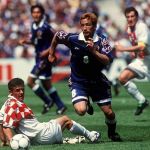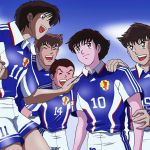
Samurai Blue - 侍青
The jersey of Japan between heritage and streetwear
June 19th, 2018
Sashiko is an ancient dyeing technique of the Japanese tradition that arose for the first time during the Edo Period (1603-1868). It consisted of a decorative seam of reinforcement, adopted above all by the rural poor communities, to repair worn clothes through a white-tipped quilting. Over time, sashiko has become an elegant needle-decoration technique, also used to embellish the fabrics that bring the kimono and the robes of Buddhist monks chasing the symbols of religious spirituality. The last frontier of sashiko is the jersey that Japan will wear in this 2018 World Cup, adidas-branded and inspired by Japanese textile craftsmanship. The home kit displays an entirely navy blue tone embellished by a pattern with vertical white points that cover the entire length of the shirt with the exception of the sleeves. The uniform is a reference to the color Kachi-iro, a particular shade of blue symbol of victory according to Japanese mythology, and it is inspired by the sashiko decorations worn by the samurai under their armor.
Blue Victory - 青い勝利
Japan's home kit is also the only one designed by adidas that does not refer to the past, although references to the ancient apparel tradition are clear. In this case, the use of blue is not justified only by the meaning assumed in the local culture but is configured as the continuation of a precise stylistic choice that sinks its roots in the first sportswear prototypes dated 1930. In that year Tokyo held the ninth edition of the Far Eastern Championship Games (forerunner of the current Asian Games) and the football team of the University of Tokyo, at that time ruler of the championship, was chosen to represent Japan. In the opening match, the players wore the university's blue representative shirt and the debut victory sounded like a warning to keep that color even in subsequent appearances. Since then the blue has always distinguished the uniforms of the national football team, with a single parenthesis between 1988 and 1992 in which the transition to the colors white and red, the same ones painted above the flag, took place.

Then came France '98 and the first historical qualification a stage on which Japan showed off an alluring and extravagant jersey due to the flames enveloping the sleeves. The key player of that shirt remained the blue, particularly appreciated in contemporary Japanese fashion, then replicated in subsequent World Cups where the side took part. All the uniforms were practically the copy of the previous ones, with the only differences dictated by the presence or absence of thin white stripes on the sleeves and the flag placed over the emblem of the federation, placed at the height of the heart. This year marks a breaking point with regard to purely aesthetic design: the nuance of blue is slightly different, as well as the font choose by adidas - squared and edgy style, inspired by the Cyrillic alphabet - while the logo of the Japan Football Association (JFA) has been updated and made less heraldic than in the past.
The streetwear trend - ストリートウェアの揺りかご

The most evocative element remains the sashiko style decoration as if to harmoniously insert that retro touch into the layout of a shirt that has become an authentic fetish for enthusiasts and collectors. Japan is considered one of the markets that have rocked the birth of the streetwear trend. Much of the credit goes to the multifaceted Hiroshi Fujiwara, who presented his collaboration with Moncler in Florence last week. Designer, DJ, and musician, he was struck by the hip-hop and street scene during a trip to New York in the Eighties. Back in Tokyo, he decided to import into his hometown that exotic mix of apparel and musical genres, combining the skate scene, underground music and American fashion in an authentic cultural bubble that cathed on the streets of the Japanese capital.

The launch of the Goodenough clothing label in 1990 and the subsequent collaborations with Louis Vuitton, Nike and Off-White have transformed Tokyo into one of the most futuristic and avant-garde poles in the streetwear scene. The entry of a new fashion in Japanese society has also contaminated football, leading to the creation of t-shirts halfway between psychedelic fantasies and the sobriety typical of the local sartorial tradition. The J League is - in fact - the laboratory in which extra-football influences can find the pinnacle of their expression, as demonstrated by the absurd aesthetics of the uniforms of some highest Japanese championship’s clubs.
Hidetoshi Nakata, Holly Hutton e Tom Byer
中田秀俊、ホリー・ハンター、トム・シティズ
The away kit is instead of a light gray tending to white and is adorned with three rectangles that start from the left shoulder and get to the chest, in homage to the shirt with which Japan won its first international trophy, the 1992 Dynasty Cup. Outside of the Asian borders, however, the path of the National side has always been stingy with joys and full of disappointments. The best results were the knockout stages achieved at the 2002 World Cup, co-hosted with South Korea, and 2010 in South Africa, while four years ago the elimination came in the group stage with just one point in three games. Yet, in the Land of the Rising Sun, football is one of the most loved, widespread and practiced sports. The merit is mainly of two people, one Japanese and the other one North American. The first to trace the path was the cartoonist Yōichi Takahashi, creator of the manga Holly and Benji who reached peaks of popularity never seen such as to make football a mainstream phenomenon able to inspire entire generations of kids. What struck, in particular, was a new way of telling football, analyzed more like a work of art - with a certain attention to the aesthetics of characters, football shirts, and rather extravagant plots - and not as a simple television transposition of the ordinary game’s situations.

The idea that even in real life someone could cherish the World Cup dream took root in millions of people, contributing to the development and launch of some of the best prodigies in the Japanese football history in the likes of Hidetoshi Nakata and Shunsuke Nakamura, later become authentic ambassadors of the Japanese football school abroad. It was Nakata who carve out a leading role in the collective imagination as an icon of style, on and off the pitch. It all began with that extravagant bronze-red hair with which he made himself known to the public and continued with adamantine performances on the Serie A fields. Having hung his shoes on the nail, his commitment to fashion did not stop and made him an accustomed guest at Dior’s and Louis Vuitton’s runway shows, so much so he was voted by L'Officiel Home China "one of the 40 most elegant icons of the last century".

The other partisan of Japan's successful football relationship was a former professional player named Tom Byer. In 2011 he organized the visit of Zinedine Zidane at a football academy and he was acclaimed with massive stadium chants by people in awe gathered in the stands of the Ajinomoto stadium in Tokyo. That exhibition was the last chapter of Byer's commitment to importing football in Japan, which developed in the 1990s through the construction of a football school in which, even before physical training, children were taught the basic requirement: the ball control, simple and clean, to which the entire development of the action is subordinated.

In addition to the strictly technical merit concerning the training of baby footballers, Byer was the architect of the diffusion of football in the local media. In 1998 he hosted a column within a children's program and later found space in a major comic magazine. The effect was striking: the football reached impressive and constantly growing peaks of interest, such as to attest to Japan as one of the main representatives of East Asia. Since 1998 the National team has always taken part in the World Cup. His nickname has remained the same: that Blue Samurai manifest of the pride with which the nation looks to its past in a present suspended between the myth of Holly and Benji and the hope that, sooner or later, even in real life the outcomes on the pitch will approach those described on the television.















